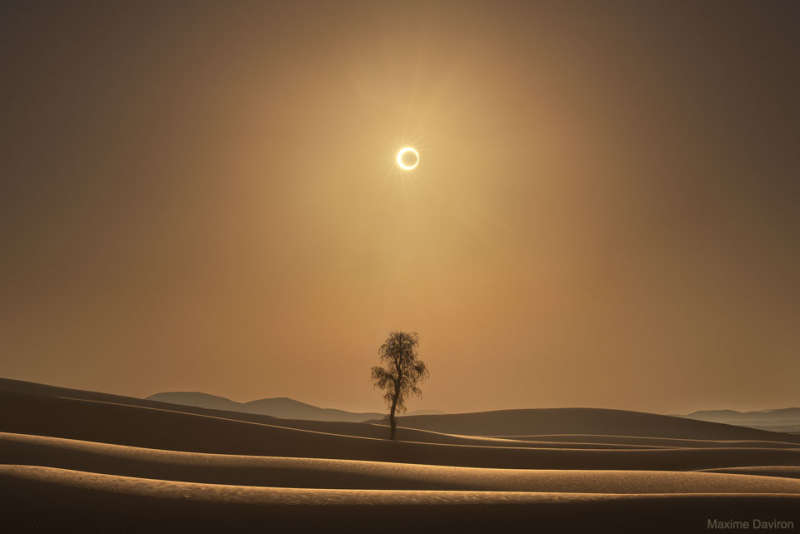Credit & Copyright: Maxime Daviron
Explanation:
A good place to see a ring-of-fire eclipse, it seemed, would be from a desert.
In a desert, there should be relatively few obscuring clouds and trees.
Therefore late last December a group of photographers traveled to the
United Arab Emirates and
Rub al-Khali,
the largest continuous sand desert in world,
to capture clear images of an
unusual eclipse that would be passing over.
A ring-of-fire eclipse is an
annular eclipse that occurs when
the Moon
is far enough away on its elliptical orbit around
the Earth
so that it appears too small, angularly, to cover
the entire Sun.
At the maximum of an
annular eclipse, the edges of the Sun can be seen all around the edges of the
Moon, so that the Moon appears to be a dark spot that covers most -- but not all
-- of the Sun.
This particular eclipse, they knew, would peak
soon after sunrise.
After seeking
out such a dry and barren place, it turned out that some of the most
interesting
eclipse images
actually included
a tree in the foreground, because, in addition to the
sand dunes,
the tree gave the surreal background a contrasting sense of normalcy, scale, and
texture.
Explore the Universe:
Random APOD Generator
1999 2000 2001 2002 2003 2004 2005 2006 2007 2008 2009 2010 2011 2012 2013 2014 2015 2016 2017 2018 2019 2020 2021 2022 2023 2024 2025 |
Январь Февраль Март Апрель Май Июнь Июль Август Сентябрь Октябрь Ноябрь Декабрь |
NASA Web Site Statements, Warnings, and Disclaimers
NASA Official: Jay Norris. Specific rights apply.
A service of: LHEA at NASA / GSFC
& Michigan Tech. U.
|
Публикации с ключевыми словами:
annular solar eclipse - кольцеобразное солнечное затмение
Публикации со словами: annular solar eclipse - кольцеобразное солнечное затмение | |
См. также:
Все публикации на ту же тему >> | |
